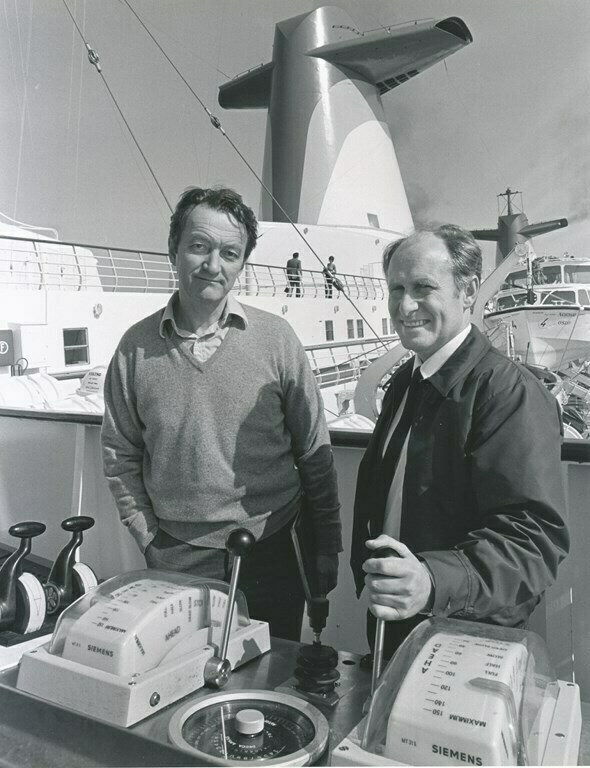 “At the beginning of 1966 my perception of the cruise industry and my vision for its development was based on the course we were setting with the Sunward,” said Knut Utstein Kloster, founder of Norwegian Caribbean Lines, today known as Norwegian Cruise Line. “We offered a one-class, exciting and affordable vacation experience for Middle America. It truly was good value for money; luxury at an economy price; Norwegian seamanship; and the Caribbean for sun and fun,” he told Cruise Industry News.
“At the beginning of 1966 my perception of the cruise industry and my vision for its development was based on the course we were setting with the Sunward,” said Knut Utstein Kloster, founder of Norwegian Caribbean Lines, today known as Norwegian Cruise Line. “We offered a one-class, exciting and affordable vacation experience for Middle America. It truly was good value for money; luxury at an economy price; Norwegian seamanship; and the Caribbean for sun and fun,” he told Cruise Industry News.
“The ship was a medium of communication,” Kloster continued, “for all those who were ‘touched’ by it – the passengers, officers, staff, crew and people in the destination communities.
“As the late scientist, writer and futurist Sir Arthur C. Clarke rightly wrote to me in a letter 40 years later: ‘There is nothing like a ship voyage to create a feeling of unity, as well as a better understanding of the wonderful planet on which we live.’”
Right Timing
“Nothing breeds success like success,” Kloster continued. “We got a flying start in the late 1960s with new modern ships, doing three-, four- and seven-day cruises to the Bahamas and Caribbean destinations.
“We were making good money, telling Americans that this was something they should want and be willing to pay for. The crux of the matter was that America was ready for it.
“Miami did its part by expanding their port and passenger services facilities. Our fly-and-cruise marketing and sales concept subsequently covered the whole country. And don’t forget the word-of-mouth support from happy passengers returning to their family and friends.”
Thus, expansion came naturally. Kloster said he just had to stay the course with more and bigger ships in a huge, untapped market. The timing was just right.
United Nations at Sea
Kloster explained that the general arrangement plan of a cruise ship prioritizes its many functions, guided by stringent safety considerations.
“We had a community onboard with officers, staff and crew of many cultural backgrounds and from different countries. Unlike working ashore, the ship was both a workplace and a home away from home.
“When the S/S Norway came to Oslo on her maiden voyage in 1980, Chief Steward Wesley Samuels from Jamaica hoisted the UN flag. It was to mark the fact that some 30 different nations were represented onboard. Thus, the S/S Norway was like a little United Nations community. It also served to remind us of our responsibility to take good care of her and her people. We did all this in the context of running a profitable business from a global perspective.”
Norwegian Caribbean
Klosters Rederi in Oslo was doing business in America as Norwegian Caribbean Lines. The ships were Norwegian owned and therefore Norwegian territory, subject to Norwegian law, Kloster explained. He said that in principle all people working aboard were supposed to be paid Norwegian wages and gambling was not allowed. A special agreement was made with the Norwegian Seafarers’ Union covering the foreign hotel and catering crew. Slot machines, however, were considered to be part of the entertainment and not considered gaming.
Later on, the Norwegian Seafarers’ Union played an important role calming national emotions in France, when Kloster acquired their national treasure, the trans-Atlantic liner S/S France, and converted her into the S/S Norway, a modern cruise ship.
Bottom Line
“The name of the game is profit,” Kloster stated. “Success is measured in terms of the return on capital, but with several interdependent bottom lines: money, human resources and the environment. We expanded the corporate agenda for the purpose of making the company profitable, respected and needed. This was free enterprise at its best.
“While it is hard to find destinations that can match the Caribbean with its many interesting and charming ports of call within comfortable reach, clearly, Europe, Asia and China are emerging markets with great potential that, combined with the Caribbean, will help propel the industry into the future.”
—
This article ran as part of a special Legends and Leaders section of the 100th edition of Cruise Industry News Quarterly Magazine, Spring 2015. A PDF download is available here.
Related articles:
Ted Arison: Creating the Fun Ships
Micky Arison: Exceeding Expectations
Nicola Costa: Developing Europe
Arne Wilhelmsen: Next: Sensible Growth
John Chandris: Innovation is Key
Art Rodney: Launching New Brands
Helge Naarstad: The Ultimate Experience
Stanley McDonald: Full Ships from Day One
Barney Ebsworth: It’s All About Marketing




